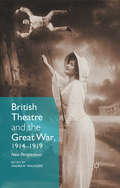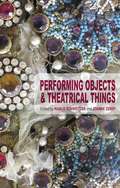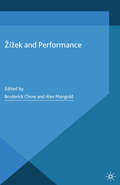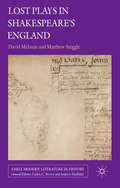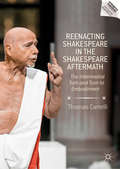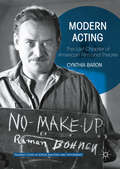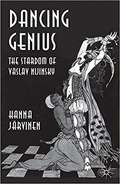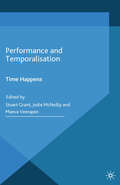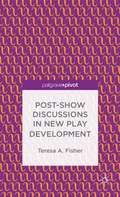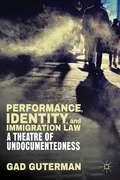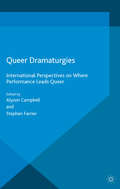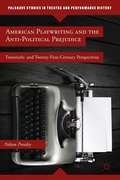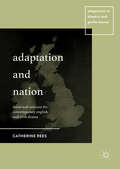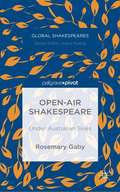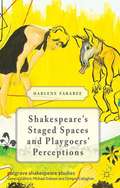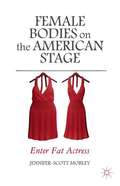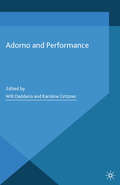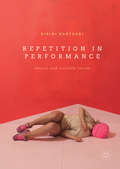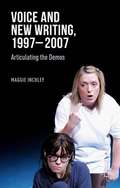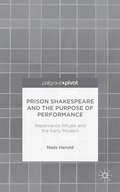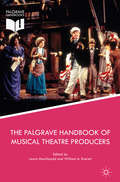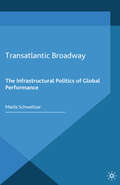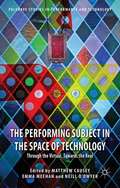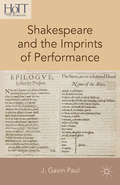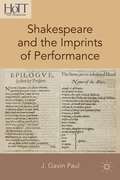- Table View
- List View
British Theatre and the Great War, 1914 - 1919: New Perspectives
by Andrew MaunderBritish Theatre and the Great War examines how theatre in its various forms adapted itself to the new conditions of 1914-1918. Contributors discuss the roles played by the theatre industry. They draw on a range of source materials to show the different kinds of theatrical provision and performance cultures in operation not only in London but across parts of Britain and also in Australia and at the Front. As well as recovering lost works and highlighting new areas for investigation (regional theatre, prison camp theatre, troop entertainment, the threat from film, suburban theatre) the book offers revisionist analysis of how the conflict and its challenges were represented on stage at the time and the controversies it provoked. The volume offers new models for exploring the topic in an accessible, jargon-free way, and it shows how theatrical entertainment of the time can be seen as the `missing link’ in the study of First World War writing.
Performing Objects and Theatrical Things
by Marlis Schweitzer Joanne ZerdyThis book rethinks historical and contemporary theatre, performance, and cultural events by scrutinizing and theorizing the objects and things that activate stages, venues, environments, and archives.
Žižek and Performance (Performance Philosophy)
by Broderick Chow Alex MangoldThe first edited volume to examine philosopher Slavoj Žižek's influence on, and his relevance for, theatre and performance studies. Featuring a brand new essay from Žižek himself, this is an indispensable contribution to the emerging field of Performance Philosophy.
Lost Plays in Shakespeare’s England
by David Mcinnis Matthew SteggleLost Plays in Shakespeare's England examines assumptions about what a lost play is and how it can be talked about; how lost plays can be reconstructed, particularly when they use narratives already familiar to playgoers; and how lost plays can force us to reassess extant plays, particularly through ideas of repertory studies.
Reenacting Shakespeare in the Shakespeare Aftermath: The Intermedial Turn and Turn to Embodiment (Reproducing Shakespeare)
by Thomas CartelliIn the Shakespeare aftermath—where all things Shakespearean are available for reassembly and reenactment—experimental transactions with Shakespeare become consequential events in their own right, informed by technologies of performance and display that defy conventional staging and filmic practices. Reenactment signifies here both an undoing and a redoing, above all a doing differently of what otherwise continues to be enacted as the same. Rooted in the modernist avant-garde, this revisionary approach to models of the past is advanced by theater artists and filmmakers whose number includes Romeo Castellucci, Annie Dorsen, Peter Greenaway, Thomas Ostermeier, Ivo van Hove, and New York’s Wooster Group, among others. Although the intermedial turn taken by such artists heralds a virtual future, this book demonstrates that embodiment—in more diverse forms than ever before—continues to exert expressive force in Shakespearean reproduction’s turning world.
Modern Acting
by Cynthia BaronEveryone has heard of Method acting . . . but what about Modern acting? This book makes the simple but radical proposal that we acknowledge the Modern acting principles that continue to guide actors' work in the twenty-first century. Developments in modern drama and new stagecraft led Modern acting strategies to coalesce by the 1930s - and Hollywood's new role as America's primary performing arts provider ensured these techniques circulated widely as the migration of Broadway talent and the demands of sound cinema created a rich exchange of ideas among actors. Decades after Strasberg's death in 1982, he and his Method are still famous, while accounts of American acting tend to overlook the contributions of Modern acting teachers such as Josephine Dillon, Charles Jehlinger, and Sophie Rosenstein. Baron's examination of acting manuals, workshop notes, and oral histories illustrates the shared vision of Modern acting that connects these little-known teachers to the landmark work of Stanislavsky. It reveals that Stella Adler, long associated with the Method, is best understood as a Modern acting teacher and that Modern acting, not Method, might be seen as central to American performing arts if the Actors' Lab in Hollywood (1941-1950) had survived the Cold War.
Dancing Genius: The Stardom of Vaslav Nijinsky
by Hanna JärvinenTracing the historical figure of Vaslav Nijinsky in contemporary documents and later reminiscences, Dancing Genius opens up questions about authorship in dance, about critical evaluation of performance practice, and the manner in which past events are turned into history.
Performance and Temporalisation: Time Happens (Performance Philosophy)
by Jodie McNeilly Maeva VeerapenPerformance and Temporalisation features a collection of scholars and artists writing about the coming forth of time as human experience. Whether drawing, designing, watching performance, being baptised, playing cricket, dancing, eating, walking or looking at caves, each explores the making of time through their art, scholarship and everyday lives.
Post-Show Discussions in New Play Development
by Teresa A. FisherMany theatres host post-show discussions, or talkbacks, as part of their season. This book is a critical examination of what has/has not worked with post-show discussions utilized in new play development, providing a framework for understanding discussions, steps for building the foundation of them, and various strategies for structuring them.
Performance, Identity, and Immigration Law
by Gad GutermanHow has contemporary American theatre presented so-called undocumented immigrants? Placing theatre artists and their work within a context of on-going debate, Guterman shows how theatre fills an essential role in a critical conversation by exploring the powerful ways in which legal labels affect and change us.
Queer Dramaturgies: International Perspectives on Where Performance Leads Queer (Contemporary Performance InterActions)
by Alyson Campbell Stephen FarrierThis international collection of essays forms a vibrant picture of the scope and diversity of contemporary queer performance. Ranging across cabaret, performance art, the performativity of film, drag and script-based theatre it unravels the dynamic relationship performance has with queerness as it is presented in local and transnational contexts.
American Playwriting and the Anti-Political Prejudice
by Nelson PressleyTwenty years after Tony Kushner's influential Angels in America seemed to declare a revitalized potency for the popular political play, there is a "No Politics" prejudice undermining US production and writing. This book explores the largely unrecognized cultural patterns that discourage political playwriting on the contemporary American stage.
Adaptation and Nation: Theatrical Contexts for Contemporary English and Irish Drama (Adaptation in Theatre and Performance)
by Catherine ReesThis book takes a novel approach to theatrical adaptation, focusing not primarily on filmic adaptations but instead on modern drama based on older, classic playtexts. The specific focus of the book is the exploration of the new national setting given to the reworked version. In exploring the way in which contemporary dramatists in England and Ireland represent a different national setting for their reworked adaptation, we can examine the specific social and political context for the new play, unearthing the cultural conditions at the time of the new setting. In examining only plays that consciously relocate the national setting for their new work, we can also explore resonances between the two different national contexts, analysing cultural and political echoes as well as shifts both geographical and temporal.
Open-Air Shakespeare: Under Australian Skies
by Rosemary GabyMany people today first encounter staged Shakespeare in an open-air setting. This book traces the history of open-air Shakespeares in Australia to investigate why the anomaly of adapting 400-year old plays under Australian skies exerts such a strong appeal.
Shakespeare’s Staged Spaces and Playgoers’ Perceptions
by Darlene FarabeeThis engaging study offers fresh readings of canonical Shakespeare plays, illuminating ways stagecraft and language of movement create meaning for playgoers. The discussions engage materials from the period, present revelatory readings of Shakespeare's language, and demonstrate how these continually popular texts engage all of us in making meaning.
Female Bodies on the American
by Jennifer-Scott MobleyThe fat female body is a unique construction in American culture that has been understood in various ways during the twentieth and early twenty-first centuries. Analyzing post-WWII stage and screen performances, Mobley argues that the fat actress's body signals myriad cultural assumptions and suggests new ways of reading the body in performance.
Adorno and Performance (Performance Philosophy)
by Will Daddario Karoline GritznerAdorno and Performance offers the first comprehensive examination of the vital role of performance within the philosophy of Theodor W. Adorno. Capacious in its ramifications for contemporary life, the term 'performance' here unlocks Adorno's dialectical thought process, which aimed at overcoming the stultifying uniformity of instrumental reason.
Repetition in Performance
by Eirini KartsakiThis book explores repetition in contemporary performance and spectatorship. It offers an impassioned account of the ways in which speech, movement and structures repeat in performances by Pina Bausch, Anne Teresa De Keersmaeker, Lone Twin Theatre, Haranczak/Navarre and Marco Berrettini. It addresses repetition in relation to processes of desire and draws attention to the forces that repetition captures and makes visible. What is it in performances of repetition that persuades us to return to them again and again? How might we unpack their complexities and come to terms with their demands upon us? While considering repetition in relation to the difficult pleasures we derive from the theatre, this book explores ways of accounting for such experiences of theatre in memory and writing.
Voice and New Writing, 1997–2007
by Maggie InchleyVoice and New Writing, 1997–2007 uses the voice as a focus for critical enquiry. It explores new writing theatres' claims to 'find' and to represent previously marginalised voices during Tony Blair's decade as Prime Minister. Hearing 'cultural evidence' for what Raymond Williams termed 'structures of feeling' in the articulation of identities, Maggie Inchley attends to the negotiation of accepted etiquettes of articulation and audibility through processes used in writing, voice training and performance. In the voices of theatre this book hears the narrative of betrayal around Anthony Giddens' 'promise of democracy', and an embattled belief in both transparency and dialogue as necessary conditions of representation. Voice and New Writing, 1997 – 2007 explores the use of voices in the work of writers including debbie tucker green, Gregory Burke, Kwame Kwei-Armah, Enda Walsh, Mark Ravenhill, and Dennis Kelly, as well as exploring the influential practice of voice teachers Cicely Berry, Patsy Rodenburg, Kristin Linklater and others.
Prison Shakespeare and the Purpose of Performance: Repentance Rituals and the Early Modern
by Niels HeroldOver the last decade a number of prison theatre programs have developed to rehabilitate inmates by having them perform Shakespearean adaptations. While twentieth and twenty-first century ideas about theatre as therapy, political resistance, and popular education hold sway for many programs, this book focuses on how prison theatre today reveals certain elements of the early modern theatre that were themselves responses to cataclysmic changes in theological doctrine and religious practice. Herold reads the Shakespearean theatre at once historically and forward ("presentising"). He examines the precise dramaturgical and ideological elements of this historical theatre that are today conducive to the remarkable rehabilitative success of prison theatre programs like Shakespeare Behind Bars.
The Palgrave Handbook of Musical Theatre Producers
by William A. Everett Laura MacdonaldThis handbook is the first to provide a systematic investigation of the various roles of producers in commercial and not-for-profit musical theatre. Featuring fifty-one essays written by international specialists in the field, it offers new insights into the world of musical theatre, its creation and its promotion. Key areas of investigation include the lives and works of producers whose work is part of a US and worldwide musical theatre legacy, as well as the largely critically-neglected role of the musical theatre producer in the making, marketing, and performance of musicals. Also explored are the shifting roles of producers in musical theatre and their popular portrayals, offering a reader-friendly collection for fans, scholars, students, and practitioners of musical theatre alike.
Transatlantic Broadway: The Infrastructural Politics of Global Performance (Transnational Theatre Histories)
by M. SchweitzerTransatlantic Broadway traces the infrastructural networks and technological advances that supported the globalization of popular entertainment in the pre-World War I period, with a specific focus on the production and performance of Broadway as physical space, dream factory, and glorious machine.
The Performing Subject in the Space of Technology
by Matthew CauseyNow that the shock of the virtual has subsided toward a 'new-normal' of computational interference in all areas of life, it is an advantageous moment to reflect on the passage through the virtual and back to the real. Digital culture has developed into a bio-virtual environment in which the categories of the biological and the virtual no longer stand as separate. The contributors to this volume respond to the questions raised by the 'after-event' of the digital through practice-led researchanalyses of performance processes, philosophical readings of the work of art and technology, and performance studies investigations of the subject in the spaces of technology. The volume examines a wide range of activities, from bio-art to internet child pornography, gaming and social networking technologies to the use of motion-tracking in developing choreography and documentation. The authors draw from diverse perspectives in dance, theatre, performance, film and music studies, digital arts and culture.
Shakespeare and the Imprints of Performance (History of Text Technologies)
by J. Gavin PaulWithin the study of drama, the question of how to relate text and performance—and what interpretive tools are best suited to analyzing them—is a longstanding and contentious one. Most scholars agree that reading a printed play is a means of dramatic realization absolutely unlike live performance, but everything else beyond this premise is contestable: how much authority to assign to playwrights, the extent to which texts and readings determine performance, and the capability of printed plays to communicate the possibilities of performance. Without denying that printed plays distort and fragment performance practice, this book negotiates an intractable debate by shifting attention to the ways in which these inevitable distortions can nevertheless enrich a reader's awareness of a play's performance potentialities. As author J. Gavin Paul demonstrates, printed plays can be more meaningfully engaged with actual performance than is typically assumed, via specific editorial principles and strategies. Focusing on the long history of Shakespearean editing, he develops the concept of the performancescape: a textual representation of performance potential that gives relative shape and stability to what is dynamic and multifarious.
Shakespeare and the Imprints of Performance (History Of Text Technologies)
by J. Gavin PaulShakespeare and the Imprints of Performance.
